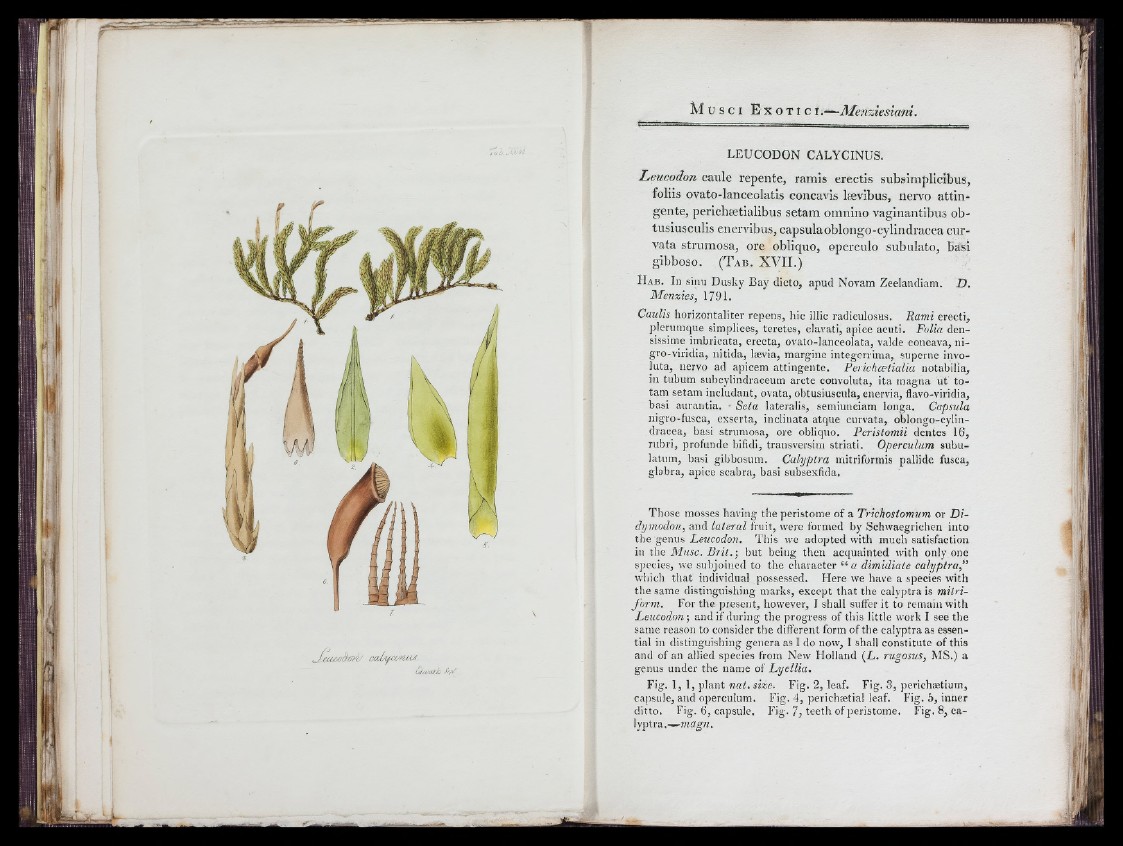
i:. 1'
I !| í:
f
J
[(¿ccodrfíV ca l/ifv ru z í
ÓLz/axh Sr/i'.
LEUCODON CALYCINUS.
Leucodon caule repente, ramis erectis subsimplicibus,
foliis ovato-lanceolatis concavis lievibus, nervo attingente,
pericheetialibus setam omnino vaginantibus ob-
tnsiusculis enervibus, capsulaoblongo-cylindracea curvata
strumosa, ore obliquo, operculo subulato, basì
gibboso. ( T a b . XVII.)
H a b . In sinu Dusky B a y dicto, apud Novam Zeelandiam. Z).
Menzies, 1791.
Caulis horizontaliter repens, hic illic radiculosus. Rami erecti,
plerumque simplices, teretes, clavati, apice acuti. Folia densissime
imbricata, erecta, ovato-lanceolata, valde concava, ni-
gro-viridia, nitida, laevia, margine integerrima, superne involuta,
nervo ad apicem attingente. Perichcetialìu notabilia,
in tubum snbcylindraceum arete convoluta, ita magna ut totani
setam includant, ovata, obtusiuscula, enervia, flavo-viridia,
basi aurantia. Seta lateralis, semiimciam longa. Capsula
nigro-fusca, exserta, inclinata atque curvata, oblongo-cylindracea,
basi strumosa, ore obliquo. Peristomii dentes 16,
rubri, profunde bifidi, transversim striati. Operculum subulatum,
basi gibbosum. Calyptra mitriformis pallide fusca,
glabra, apice scabra, basi subsexfida.
Those mosses having the peristome of a Trichostomum or Di-
dymodon, and lateral fruit, were formed by Schwaegrichen into
the genus Leucodon. This we adopted with much satisfaction
in the Muse. Brit.-, but being then acquainted with only one
s]iecies, we subjoined to the character “ a dimidiate calyptra,”
which that individual possessed. Here we have a species with
the same distinguishing marks, except that the calyptra is milri-
Jorm. For the present, however, 1 shall suffer it to remain vvith
Leucodon-, and if during the progress of this little work I see the
same reason to consider the different form of the calyptra as essential
in distinguishing genera as I do now, 1 shall constitute of this
and of an allied species from New Holland (L. rugosus, MS.) a
genus under the name of Lyellia.
Fig. 1, 1, plant iixe. Fig. 2, leaf. Fig. 3, periehaetium,
ca])sule, and operculum. Fig. 4, perichsetia! leaf. Fig. 5, inner
ditto. Fig. 6, capsule. Fig. 7, teeth of peristome. Fig. 8, calyptra.—